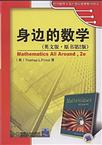身边的数学
出版时间:2009-3 出版社:机械工业 作者:皮纳德 页数:847
Tag标签:无
前言
由Thomas L.Pirnot编著的Mathematics Au Around一书是为从事社会科学、教育学、商业、艺术和其他非理工类专业的学生而写的教学教科书。本书可以使从事这些专业的学生理解并欣赏到数学在各个领域的许多精彩应用。本书共14章,内容包括集合论、数理逻辑、图论、数论、统计、概率、代数、几何等。全书以数学的应用作为动机,每一章的开始提出实际问题,然后发展必要的数学工具,再解决这些实际问题,在应用中进一步加强对数学的理解。因此提出问题和解决问题占本书很大篇幅。众多应用问题中有些联系日常生活:如信用卡购物问题,分期付款与抵押贷款问题,年利率的计算,运动队成绩的评价,彩票获奖的几率,股票市场中的决策问题,疾病的传播问题,席位的公平分配问题,唱片销售的回归模型等;有些是著名的数学问题:如四色问题,TSP问题(Traveling Salesman Problem);也有些是数学在高新技术中的应用问题:如模糊逻辑用于空调系统,矩阵用于医学计算机成像、图形加速和计算机图形学,分形用于人体中血管、气管的研究,用于创作逼真的自然景观。总之它们使本书变得越味横生。全书贯穿着强烈的应用意识,使数学理论紧密联系政治、经济、体育、艺术、医学、生物、科技、环境等方面的实际问题,这在国内外数学教科书中是不多见的。本书还从教育学的角度对叙述方式和版面作了精心安排,使得所有概念和理论都由浅人深,因此本书在阅读时易读好懂。为了引导学生掌握正确的学习方法,作者还在第一章的第一节讨论了解决实际数学应用问题的策略和原则,并提供用以下方式来解决数学问题:1.画图;2.用自己的语言叙述问题;3.理清问题的条理;4.找规律;5.简化问题;6.猜想;7.将新问题变为老问题。本书除了可作为社会科学、教育学、商业、艺术等文科专业的教材以外,还可以作为理工类学生、教师、工程技术人员和管理工作者的参考书或工具书。
内容概要
本书是为从事社会科学、教育学、商业、艺术和其他非理工类专业的学生而写的数学教科书,可以使从事这些专业的学生理解并欣赏到数学在各个领域的许多精彩应用。内容包括集合论、数理逻辑、图论、数论、统计、概率、代数、几何等。全书以数学的应用作为动机,每一章的开始提出实际问题,然后发展必要的数学工具,再解决这些实际问题,在应用中进一步加强对数学的理解。全书贯穿着强烈的应用意识,这在国内外数学教科书中是不多见的。
作者简介
作者:(美国)皮纳德
书籍目录
出版说明序1 SET THEORY: Using Mathematics to Classify Objects 1.1 Problem Solving 1.2 Estimation 1.3 The Language of Sets 1.4 Comparing Sets 1.5 Set Operations 1.6 Survey Problems Chapter Summary Chapter Test Of Further Interest: Infinite Sets 2 LOGIC: The Study of What's True or False or Somewhere in Between 2.1 Inductive and Deductive Reasoning 2.2 Statements, Connectives, and Quantifiers 2.3 Truth Tables 2.4 The Conditional and Biconditional 2.5 Verifying Arguments 2.6 Using Euler Diagrams to Verify Syllogisms Chapter Summary Chapter Test Of Further Interest: Fuzzy Logic 3 GRAPH THEORY: The Mathematics of Relationships 3.1 Graphs, Puzzles, and Map Coloring 3.2 The Traveling Salesperson Problem 3.3 Directed Graphs Chapter Summary Chapter Test Of Further Interest: Scheduling Projects Using PERT4 NUMERATION SYSTEMS: Does it Matter How We Name Numbers? 4.1 The Evolution of Numeration Systems 4.2 Place Value Systems 4.3 Calculating in Other Bases Chapter Summary Chapter Test Of Further Interest:Modular Systems 5 NUMBER THEORY AND THE REAL NUMBER SYSTEM: Understanding the Numbers All Around Us 5.1 Number Theory 5.2 The Integers 5.3 The Rational Numbers 5.4 The Real Number System 5.5 Exponents and Scientific Notation Chapter Summary Chapter Test Of Further Interest: Sequences 6 ALGEBRAIC MODELS: How Do We Approximate Reality? 6.1 Linear Equations 6.2 Modeling with Linear Equations 6.3 Modeling with Quadratic Equations 6.4 Exponential Equations and Growth 6.5 Proportions and Variation Chapter Summary Chapter Test Of Further Interest: Dynamical Systems 7 MODELING WITH SYSTEMS OF LINEAR EQUATIONS AND INEQUALITIES:What's the Best Way to Do It? 7.1 Systems of Linear Equations 7.2 Systems of Linear Inequalities Chapter Summary ……8 GEOMETRY:Ancient and Modern Mathematics Embrace9 APPORTIONMENT:How Do We Measure Fairness?10 VOTING:Using Mathematics to Make Choices11 CONSUMER MATHEMATICS:The Mathematics of Everyday Life12 COUNTING:Just How Many Are There?13 PROBABILITY:What Are the Chances?14 DESCRIPTIVE STATISTICS:What a Data Set Tells Us
章节摘录
插图:Little was done to develop the theory of counting until the sixteenth century, when mathematicians began to analyze games of chance. While answering questions about throwing dice and drawing cards, a group of Eu- ropean mathematicians began to organize their results into a formal theory of counting. One of the most prominent figures in this development was the French- man Blaise Pascal, who wrote a paper in 1654 dealing with the theory of combinations.Pascal was a child prodigy who became inter- ested in Euclid's Elements at age twelve. Within four years he was doing original research and wrote a paper of such quality that some of the leading mathemati- cians of the time refused to believe that it had been written by a sixteen-year-old boy.Pascal later abandoned mathematics to devote himself completely to philosophy and religion. In 1658, however, while unable to sleep because of a toothache, he decided to think about geometry to take his mind off the pain and, surprisingly, the pain stopped. Pascal took this as a sign from heaven that he should return to mathematics. For a short while he re- turned to his research, but soon became seriously ill with dyspepsia, a digestive disorder. Pascal spent the remaining years of his life in excruciating pain, doing little work until his death at age 39 in 1662.
编辑推荐
《身边的数学(英文版)(原书第2版)》是皮纳德编写的,由机械工业出版社出版。
图书封面
图书标签Tags
无
评论、评分、阅读与下载
用户评论 (总计9条)
- 会从很基本的东西开始学,内容对于大多数中国本科学生来说相对容易,但是可以学会英文数学的表述方式。
- 既可以轻松的学英语,还可以快速的掌握数学专业英语词汇。
- 本想给学生用的,不过不太适合英文底子薄的孩子。内容简单,不过英文表达的方法还是有的学了。个人喜欢中``````
- 是英文原版,书的难度不大,我这个四级过了六级没过的人读起来没什么难度,有些生单词会把读书的进度拖慢,有些不爽,不过这不是书的问题。文科生应该看看,就算不是为了学英语,这本书里的东西也是我们很欠缺的。
- 双语开拓世界
- 两个版本的都买了,对照着看,顺便学习英语啊
- 就当是学外语的工具
- 对工作和学习有用,还可以增强英语能力
- 首先,卓越的服务是很好的。但这本书是我网购最失望的书之一!机械工业出版社出书也太水了!16开的印刷。里面每一页的留白都占1/4。大量的空白不知留着干什么?正文字母大小如四六级考卷阅读理解的字号大小。这样,我一边捧着老重的书(有3-4厘米厚吧),一边看着蚂蚁似的字,每页还只有3/4的信息量。强烈鄙视这种愚蠢的出版商和编辑!强烈建议不购买!
